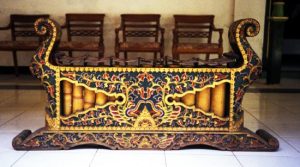Acquired: during the Reign of Sultan Hamengku Buwana II or III
Type of Gamelan: common practice–modernized
Tuning: sléndro

Sources differ in regard to when K.K. Marikangen (“end of yearning”) was built. Kertanegara[1] dates the making of this common practice gamelan sléndro to the reign of the Second Sultan (1792-1810), Purwodiningrat[2] to that of the Third Sultan (1810-1814). It seems safe to say this set came into existence around the turn of, or early in, the 19th century. This gamelan, along with the common practice gamelan pélog K.K. Bremara[3] were associated with the prajurit (soldiers) Langenkusuma, an all-female division of the palace troops. Kertanegara[4] says that these gamelans were actually performed by members of Langenkusuma for their own entertainment inside the palace. In comparison to almost all other palace gamelans, K.K. Marikangen is diminutively proportioned, making it appropriate for use by female musicians. Purwodiningrat[5], however, reports that K.K. Marikangen was used to accompany the jousting exercises of the Langenkusuma troops in the more public Alun-alun (square). Which of these sources is more historically accurate is difficult to say, but the association between these gamelans and female prajurit during the first half of the 19th century seems certain and supported in part by the unusually small size of several of the instruments in these gamelans. By the reign of the Sixth Sultan the prajurit Langenkusuma apparently no longer existed and the use of K.K. Marikangen in the artistic life of the palace was redefined. It was now used to accompany highly refined and symbolically rich female ensemble dances called bedhaya and elaborate dance dramas called ringgit tiyang or wayang wong. Also at this time it became the ensemble of choice to be used for the yearly shadow puppet play (wayang kulit) performance known as bedhol songsong, which marked the end of Grebeg Sawal, the palace celebration that takes place at the end of the Muslim month of fasting (Ramadan). In 1925 the Eighth Sultan loaned this set to the palace-sponsored puppeteer school Habirandha, where it remained until the late 1990s when the set was returned to the palace. At some time in the 20th century the original pre-modern instrumentation of this set was partially modernized with the addition of a few key instruments. Total modernization of its instrumentation and repair and repainting of its casings were underway in 1999, when I first saw this gamelan at the residence of G.B.P.H. Yudhaningrat, and completed by 2007. In 2016 the set was once again being used for pedagogical ends–it is now at the Sekolah Karawitan Kridhamardawa (“Gamelan Music School of Kridhamardawa” [the performing arts division of the palace]), which is located at nDalem Yudhanegaran, the current residence of G.B.P.H. Yudhaningrat, a younger brother of the current sultan and the head of Kridhamardawa.
On the three occasions I have seen this gamelan (1999, 2007, and 2016) it did not have a bonang panembung or gambang gangsa, yet some inventories list these instruments for this set. I have seen its slentho, but without its wilahan (keys). K.K. Marikangen now includes a gendèr panembung and a gendèr penerus, as well as a full array of kenong jaler and kempul gongs–all typical additions made when a pre-modern set is modernized. Only a single, unnamed, gong ageng is currently with the gamelan, and a single gong siyem is suspended next to it. I have encountered another gong siyem that must have at one time been a part of this set but is currently part of another gamelan sléndro, K.K. Pusparana. On the back of this gong is written in Javanese script “gong bibar watang \ kangjeng kyahi marikangngen” (“gong after jousting \ K.K. Marikangen”). This inscription appears to make reference back to the earliest association between K.K. Marikangen and the female prajurit brigade Langenkusuma. Why this gong siyem is currently with K.K. Pusparana rather than K.K. Marikangen I cannot say, but over the years I have noticed that there are a number of palace gong ageng in particular that have migrated from one gamelan to another.
K.K. Marikangen is painted a dark green (ijem sepuh) with detailed highlight in gold, green, brown and purple. A flame motif is used for the borders of the instruments, and some of the instruments have their open spaces filled with carvings of vegetation (lunglungan). The main figural motif for this gamelan is facing garuda heads. Between and below the two garuda is possibly a solar wheel (chakra, an attribute of the Hindhu god Vishnu) highlighted in gold. As can be seen in the photo at the top of this page, the gendèr-type instruments in this set have mataraman style casings. Another feature of this gamelan is the diminutive size of the gongs on its double-row gongchime instruments (bonang), a design feature which perhaps reminds us of the original intended use of this set for performance by women.
Inventory:
gong ageng (1)
gong siyem/suwukan (1)
kempul (5)
kenong jaler (5)
kenong japan (1)
kethuk (1)
bonang barung (1)
bonang penerus (1)
saron demung (2)
saron ricik/barung (4)
gendèr penembung/slenthem (1)
gendèr barung (1)
gendèr penerus (1)
gambang kayu (1)
clempung/celempung (1)
kendhang ageng/gendhing (1)
kendhang ketipung (1)
kendhang alit/batangan (1)
suling (4)
bendhé (general use instrument shared with other gamelans)
bedhug (general use instrument shared with other gamelans)
rebab (general use instrument shared with other gamelans)
siter (general use instrument shared with other gamelans)
kemanak (general use instrument shared with other gamelans)
kecèr (general use instrument shared with other gamelans)
keprak (general use instrument shared with other gamelans)


